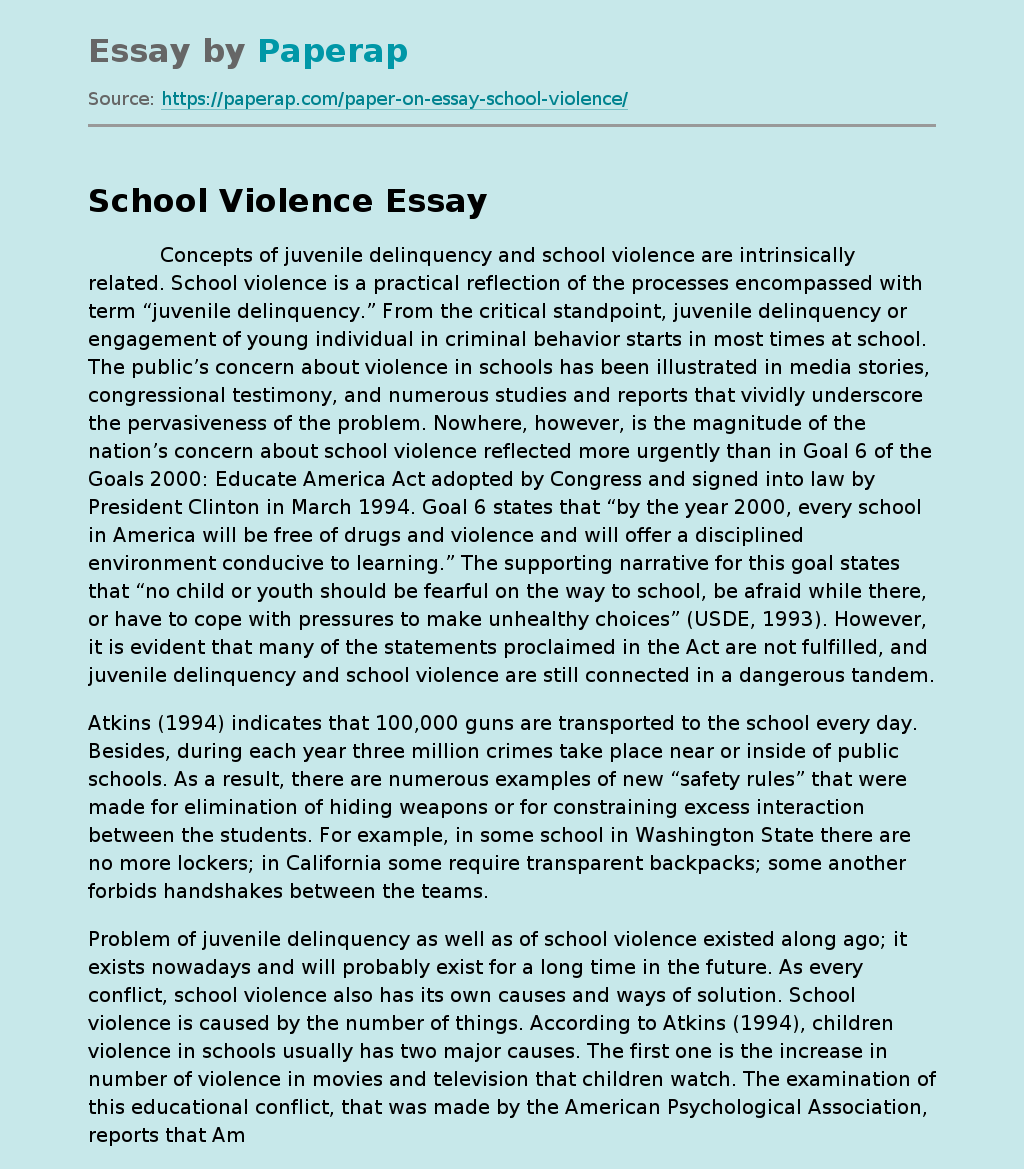School Violence
Concepts of juvenile delinquency and school violence are intrinsically related. School violence is a practical reflection of the processes encompassed with term “juvenile delinquency.” From the critical standpoint, juvenile delinquency or engagement of young individual in criminal behavior starts in most times at school. The public’s concern about violence in schools has been illustrated in media stories, congressional testimony, and numerous studies and reports that vividly underscore the pervasiveness of the problem. Nowhere, however, is the magnitude of the nation’s concern about school violence reflected more urgently than in Goal 6 of the Goals 2000: Educate America Act adopted by Congress and signed into law by President Clinton in March 1994.
Goal 6 states that “by the year 2000, every school in America will be free of drugs and violence and will offer a disciplined environment conducive to learning.” The supporting narrative for this goal states that “no child or youth should be fearful on the way to school, be afraid while there, or have to cope with pressures to make unhealthy choices” (USDE, 1993).
However, it is evident that many of the statements proclaimed in the Act are not fulfilled, and juvenile delinquency and school violence are still connected in a dangerous tandem.
Atkins (1994) indicates that 100,000 guns are transported to the school every day. Besides, during each year three million crimes take place near or inside of public schools. As a result, there are numerous examples of new “safety rules” that were made for elimination of hiding weapons or for constraining excess interaction between the students.
For example, in some school in Washington State there are no more lockers; in California some require transparent backpacks; some another forbids handshakes between the teams.
Problem of juvenile delinquency as well as of school violence existed along ago; it exists nowadays and will probably exist for a long time in the future. As every conflict, school violence also has its own causes and ways of solution. School violence is caused by the number of things. According to Atkins (1994), children violence in schools usually has two major causes. The first one is the increase in number of violence in movies and television that children watch. The examination of this educational conflict, that was made by the American Psychological Association, reports that American children see about eight thousand murders on the television and around one 100,000 of other violent performances before they start attending junior high school. Importantly, yet more violent acts are depicted on television, sales of video games depicting death and destruction are skyrocketing, and many rock videos show violence as a viable means of conflict resolution.
Violence In Schools Essay
The second cause explains that children violence may appear as a result of poverty. Indeed, the problem of poverty is strongly connected with school violence. Poverty in families is usually neighboring with alcoholism, child abuse, bullying and agression. Moreover, many incarcerated adolescents are characterized as having behavioral and emotional problems that would qualify them for special education or residential treatment programs. Nelson and Rutherford (1989:10-11) indicated that 77% of incarcerated students receiving special education services were behaviorally disordered.
Many publications present horrifying statistics on violence in the United States. The Carnegie Quarterly report states that “nearly one million adolescents between the ages of twelve and nineteen are victims of violent crimes each year” (Hechinger, 1994:5). Marion Wright Edelman tells that an American child is killed every two hours by guns, and thirty more are injured each day (Edelman, 1994). The figures vary some from report to report, but they are never less than appalling. Sociologists, educators, and others who study the phenomenon of violence blame it variously on poverty, doing poorly in school, lack of social skills, hopelessness with respect to getting a job, the influence of television and movies, and a general failure of morals in society at large. School programs aimed at reducing delinquency sometimes target one of these presumed causes – for example, doing poorly in school – and try to prevent violence by removing the cause.
It is not at all clear that violence prevention programs are working. The Carnegie report suggests that some are, but a recent Harvard Education Letter article (1994) raises serious doubts about all such special programs. The best course of action seems to be to transform the whole school climate. In a caring climate, in a “full-service school,” violence prevention programs may add the skills and knowledge needed to resist particular forms of violence. Basically, however, students must believe that the adults in their schools and communities care about them, that their well-being and growth matter. Kids seem able to survive material poverty, and many can ignore much of the violence in the media – or, at least, keep its effects to a minimum – if they have continuing relationships with adults who obviously care about them. According to Atkins (1994), parents should confine television, extend their child’s social life, and make sure that any weapon is out of children’s reach. They should also teach their child how to overcome the problems themselves and discuss possible ways of solving with them.
Since juvenile delinquency origins in American schools through violence and other conflicting and anti-social behavior, the understanding of the school violence is pivotal to understanding and interpreting trends of juvenile delinquency. Violence prevention strategies conducted in school setting, various couselling programs for high school students, social support programs may have significant affect on the dynamics of juvenile delinquency.
School Violence. (2019, Dec 05). Retrieved from https://paperap.com/paper-on-essay-school-violence/

